Global Changes Gang Up on Plans, Forecasts
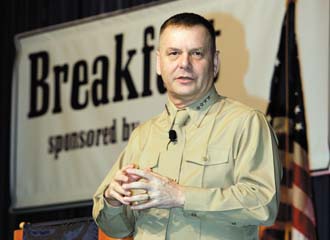 |
Gen. James E. Cartwright, USMC, vice chairman of the Joint Chiefs of Staff, describes the changes driving the new Quadrennial Defense Review at West 2010. |
The information revolution that is sweeping the globe is forcing radical changes in the national security arena. Previous notions of strategic and tactical military planning are being swept away as both time and power have new definitions. And, that information technology realm itself is a major player in the concept of national security.
That was just one message delivered in West 2010, presented by AFCEA International and the U.S. Naval Institute February 2-4, 2010, in
The QDR represents overdue changes in the defense structure, but this year’s version is unusual because it comes in with a new presidential administration but a holdover secretary of defense. Thus, it maintains an unusual degree of continuity, but it does signal a new direction for the military.
Gen. James E. Cartwright, USMC, vice chairman of the Joint Chiefs of Staff, led off West 2010 by citing that perspective and predicting greater changes next year. Gen. Cartwright explained why the QDR abandons the concept of fighting two conventional wars along with lesser conflicts simultaneously. Simply put, the lesser conflicts are proving much more difficult than imagined, while the major wars seem less likely. It is more important to focus on the wars the
“Whatever it is that we think we’ll do next, whomever it is we think we’ll fight next, we’ll be wrong,” he stated.
Developments in missile defense have led to a capability that is international in nature and agnostic in application, Gen. Cartwright noted. He allowed that missile defense is much more capable than it was 10 years ago. He cited its multilayered international capability that provides greater defense around the world. “We have moved to a distributed global capability that is agnostic to where it is set up and delivered,” the general said, adding that this system shares awareness with people who are not necessarily allies. Not only is the
And, a healthy economy is important to national security, he pointed out. “We’re in a major economic crisis. Economics is a big part of warfare. If you ignore it, you’ll do it at your nation’s peril,” the general declared.
This economic element also touches upon the change that is sweeping business. “We’re moving from an industrial construct in an industrial age into one that looks more like
“The QDR is helping us, along with the budget, to align our forces according to the fight we’re in.”
One of the most important elements in the new defense construct is the standup of the U.S. Cyber Command, he continued. Unlike some other commands, it will be kept in line with the warfighter, he emphasized. In the civilian realm, cyberspace security is a key element of national security. Military officials are trying to develop a way to defend cyberspace amid cultural and legal challenges.
“We have no authority in the Wild Wild West called .com, but we still operate there,” he explained. “We are working very hard to find a construct in which it is appropriate for the average American to go on the network and elect to have higher protection levels that allow us to protect them. We want to be able to separate these networks, creating DMZs [demilitarized zones] around these networks that allow higher security.”
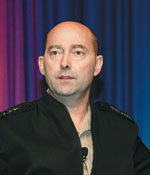 |
Adm. James G. Stavridis, USN, commander of the U.S. European |
This cyberthreat is more than just another problem. It well could be the opening shot of a future war. Adm. Stavridis noted that
The admiral noted that NATO’s Article V provides for the common defense in the event of an attack on any one member. Article VI defines an attack. He said that NATO needs to re-consider the definition of an attack in light of the emergence of cyberspace, which did not exist when NATO was formed.
“I believe that it’s more likely that an attack will come from not a bomb off a bomb rack, but instead electrons in cyberspace,” Adm. Stavridis declared.
Cyber issues were the focus of an entire panel discussion. Vice Adm. Nancy Brown, USN (Ret.), former J-6, the Joint Staff, led off her panel session by challenging the members to offer their solutions to a number of problems in the cyber domain. She asked them to answer the questions: How do you ensure that software is secure? With so many partners—both national and international—how do you acquire situational awareness of networks? How can partners share information horizontally? What’s the best way to develop cyber tactics, techniques and procedures? While panelists couldn’t address all these issues, they did speak candidly about the overall state of cyber—from security to resiliency.
 |
Vice Adm. Nancy Brown, USN (Ret.), former J-6, the Joint Staff (r), leads a panel discussion about priorities in the cyber domain. Panelists included (l-r) Robert J. Carey, DON CIO; Dr. Norman Friedman, author; Terry Roberts, executive director at Carnegie Mellon’s Software Engineering Institute; and Vice Adm. Carl V. Mauney, USN, deputy commander, STRATCOM. |
Vice Adm. Carl V. Mauney, USN, deputy commander, U.S. Strategic Command (STRATCOM), emphasized the importance of confirming the truth of all the information that’s gathered and shared. “Commanders rely on IT for C2 [command and control]—to move information, to make decisions—and we must be able to believe in that information. That is the real problem with the Internet. You can’t always count on the validity of the info,” he said. “We need to continue to identify and resolve vulnerabilities in our networks. We have not done that very well, and we need to fix that.”
Terry Roberts, an executive director with Carnegie Mellon’s Software Engineering Institute and former deputy director of naval intelligence, said that when it comes to cyber defense, the U.S. Defense Department and other federal agencies have been chasing their tails because everyone looked to STRATCOM as the leader for cyber defense but has not had the authority to do what needed to be done. With the establishment of U.S. Cyber Command, a sub-unified command under STRATCOM, the best of the best personnel from each service has the leadership it needs to be truly effective.
The recalcitrant regime in
She also said that waiting for the Kim Jong Il regime to go away is not the best and brightest option. “They have a black belt in survival,” she analogized. She offered four options: continue to conduct diplomacy with the goal of increasing international pressure on
While the unexpected may define
It is quite clear that the actions seen last year are part of
And
Growing Piracy Raises Alarms, Calls for Solutions
 |
Piracy panelists (l-r) Capt. Chuck Wolf, USN; Rear Adm. Terence E. McKnight, USN; Col. David W. Coffman, USMC; and Dr. Virginia Lunsford discuss the multifaceted issues confronting the war on piracy. |
In addition to Lunsford, panel members included Capt. Chuck Wolf, USN, commander, Naval Special Warfare Group 4; Rear Adm. Terence E. McKnight, USN, Expeditionary Strike Group 2, and commander, Task Force 51/59/151; and Col. David Coffman, USMC, commander, 13th Marine Expeditionary Unit. Although these experts agreed on the causes of piracy, they did not fully agree on what needs to be done to stop it. While Col. Coffman emphasized that his unit’s role is to defend
Even Adm. McKnight agreed that resolving piracy issues is a complicated and complex issue. One move by the U.S. Defense Department that has contributed to the complexity has been the creation of U.S. Africa Command. Although the command was created to bring some semblance of order to the issues in the area and solutions through African national cooperation, in fact it has created a chasm between the responsibilities that have belonged to U.S. Central Command large enough for pirates to sail right through.
Panelists and audience members raised a number of other circumstances that have been contributing to the piracy fight. For example, should the
Defining a New Navy May Be More Elusive Than Funding It
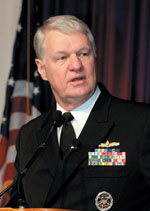 |
Adm. Gary Roughead, USN, chief of naval opererations, describes a future info-centric Navy to luncheon attendees. |
“Our way forward must be centered on information and how we use it,” Adm. Roughead declared.
One of the key requirements of information is to protect it, and the admiral outlined plans for building a new career track of cyberspace experts. As many as 44,000 sailors are serving in this information group, and the Navy is creating billets for cyber warfare engineers to test computer network defense against software attack. The selection of these top-notch engineers will be similar to that of men and women of the nuclear power force, he noted. And, the Reserve component will serve as an important surge capability, with the Navy positioning some cyber centers near Reserve centers.
Adm. Roughead continued that information and intelligence are so inexorably linked that he decided to combine the two in the Navy. “We’re moving out in the area of information dominance,” he stated. “Last summer, I moved to combine our directorate of intelligence [N2] with the directorate of communications [N6]. I don’t take reorganizations lightly, but I was convinced this was the way to go.”
The admiral mentioned several key technologies that the Navy will need to maintain its supremacy in the information age. One is unmanned vehicles and systems, which are the key to moving information. The admiral noted that the Navy has deployed a vertical takeoff unmanned aerial vehicle (UAV) on a ship involved in counterdrug operations in the eastern
Unmanned underwater vehicles also will be vitally important, but Adm. Roughead warned that their current power limits curb their effectiveness. “All the underwater sensors in the world will be useless if they have to come out of the water every 24 hours,” he stated. “We need power, and we need it quickly.”
Being able to afford new technologies and systems always is a challenge for any service, but the Navy is facing a critical moment as it weighs needed modernization against increasing budgetary pressures. A panel on affordability waxed and waned on the Navy’s ability to realize its technology needs.
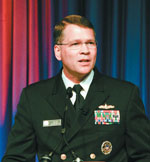 |
Vice Adm. David J. "Jack" Dorsett, USN, the Navy’s first Deputy Chief of Naval Operations for Information Dominance (N2/N6), describes the rationale of the new construct. |
To address these points, the Navy is nearly finished creating road maps for several areas in the information technology field. These road maps are being kept high and tight so that they are documents of action rather than documents collecting dust, the admiral stated. In addition, these plans will be shared with industry this year up to and including the classified level.
Adm. Dorsett related that the road map includes the principles that will be carried through plans for every sensor as well as how to network these sensors and how any shooter will be able to draw information and intelligence from the network. Sensors must not be stovepiped, the admiral stressed.
Under this general umbrella, road maps either have been or are being developed in several categories. These include undersea dominance; maritime intelligence, surveillance and reconnaissance; maritime ballistic C2; improved maritime domain awareness; unmanned systems; the Navy’s role in cyber offense and defense; fire control; integrated sensors; and C2 at the tip of the bow. “This is a fundamental break from how this has been done before,” Adm. Dorsett said.
The admiral also emphasized that industry must be brought in earlier during the research, development and decision-making process. In this way, the Navy will benefit from knowing the available solutions, and industry will know where and how to spend its research and development resources. In fact, the service will share its road maps with industry partners at the classified level, first during a forum in June and again in September. During the first event, the Navy will discuss its requirements; during the second, industry is expected to come to the table with its ideas and solutions, he explained.
 |
David Hartman (l) moderates the breakfast dialogue panel focusing on the future of the U.S. Navy with panelists (l-r) Cdr. Bryan McGrath, USN (Ret.), and Undersecretary of the Navy Robert O. Work. |
One answer was a modern navy, according to Cdr. Bryan McGrath, USN (Ret.), director of consulting, studies and analysis, Delex Systems Incorporated. Cdr. McGrath noted that today’s Navy was designed in the Jimmy Carter administration to defeat the
And flexibility will be more important than numbers, according to Robert O. Work, undersecretary of the Navy. The Navy must maintain a persistent global presence, support counterinsurgency, support maritime security operations and must maximize the capability of every platform in the fleet, he declared. “We neither want nor need a regional navy,” he said, adding “we want a true global deployable navy.”
McGrath charged that the Navy is oversubscribed in land attack. “We don’t spend enough time and energy on what navies do: sea control,” he declared. He called for the development of a “navy-killing navy,” adding that a navy built around that capability would be able to conduct most of the other operations that could arise.
“Congress has a good record of giving us what we ask for,” McGrath added. “The problem is, are we asking for the right thing? Congress is cocked and loaded to give us more resources. We just have to ask them.”
 |
Panelists discussing the affordability of new Navy technologies include (l-r) Thomas Hone, Naval War College Liaison with OPNAV; Lou Von Thaer, corporate vice president, General Dynamics and president, General Dynamics Advanced Information Systems; Vice Adm. Jack Dorsett, USN, new N2/N6; Robert O. Work, undersecretary of the Navy; and panel moderator Richard Diamond Jr., strategic planner, Raytheon IDS Strategic Assessments. |
Thomas Hone, Naval War College Liaison with OPNAV, called for industrializing the production of software. “We don’t have software that can make software,” he observed, and he drew a historical parallel to how the automobile became ubiquitous after Henry Ford automated its construction to mass-produce millions. Great achievements can take place when software is mass-produced, he said.

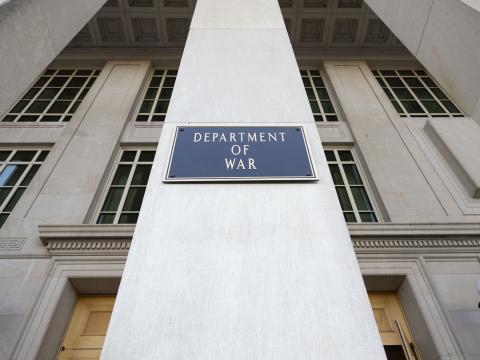


Comments